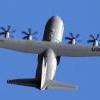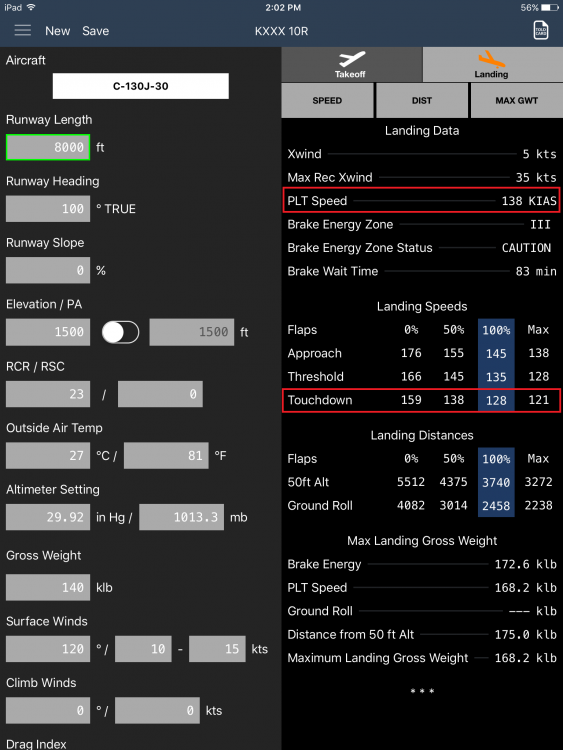-
Posts
124 -
Joined
-
Last visited
Content Type
Profiles
Forums
Gallery
Blogs
Downloads
Wiki
Everything posted by HerkPerfMan
-
I don't think any of the "XL" or "wide body" designs ever got past the study phase since there was never a formal requirement for USAF.
-
That about sums it up. They had several good proposals and the technical capability to back it up, but couldn't get traction. LM's competing resources and friends in high places probably had something to do with it as well. I'm not sure the current status of their C-130A...it may be beer cans by now. In the '80s, it appears Lockheed was enamored with the three-hole design after the L-1011 TriStar design. From the same link that Clark posted, I was pleased to see this photo of yet another Herc variant for the Navy with 3 turbofans replacing the 4 turboprops. I remember seeing this design previously but not in the public domain. The ECX-130 (and KCX-130 for the tanker variant) had a completely redesigned aft body with a T-tail, similar to the C-141. But they left the nose exactly the same. This would have been an interesting sight, to say the least.
-
LM ended up partnering with Alenia on the C-27J briefly around the time of the JCA program, rather than build a twin-engine "mini Herc." Snow Aviation developed some interesting mod packages for legacy C-130s but never signed any customers. They were trying to compete with the J by offering performance and avionics upgrades (referred to as "C-130M") as an alternative to fleet recapitalization with Js. Snow had a C-130A that they had a lot of fun with - they were the first to fly with the 8-blade props (NP2000). Snow developed a wingtip fuel tank too as a replacement for the underwing tanks. It had many advantages in lift distribution, aileron effectiveness, and stall delay. Never made it past flight testing.
-
I would put my money on "microvanes" for more drag reduction, less weight, and fewer integration headaches...but winglets are sexier. Here is a good summary of all the drag reduction initiatives in work at LM, as of 2012. https://www.codeonemagazine.com/article.html?item_id=91
-
MC-130J with winglets spotted at KCEW.
-
I have distributed several 30-day trials of C-130J preTOLD for iPad and received very positive reviews - is anyone else interested in trying it out and introducing it around your squadron? If so, please sign up here. For now, I can only offer the trial to U.S. persons currently located within the U.S. But any others interested can view our demonstration video.
-
Yep, I know that method for the brake energy and I can use it since it is in the -1-1. It qualifies as a "linear approximation" and was most likely developed to make it faster to run the charts by hand. I can actually try both methods and compare the results. I agree that the brake management setup on the J is not modern by any definition of the word, but at least you have brake energy planning data and calculation methods on the J. The H-1-1 does not even mention brake energy limitations or cooling times and it has the same configuration.
-
The wing is still straight with an even higher aspect ratio, so it wouldn't reach transonic cruise speeds. Instead, the designers opted for much improved low-speed capability with the augmented lift system. It's definitely an internally blown flap system (vs externally blown like the YC-15 or C-17) to drop the stall speed that much. Very effective system, but also complex. The next best thing is some big props moving massive amounts of air over the wings and flaps.
-
The number and variety of C-130 mod proposals never ceases to amaze me. This a treasure trove of little-known proposals and a catalog of detailed engineering data on the Credible Sport and HTTB variants. All the engineering work was done on the double-slotted flaps, so why aren't they on the J?! I particularly like the "air cushion landing system." Never seen that one before...certainly a different twist on an amphibious Herc.
-
No doubt Antonov is developing the An-178 as a "multi-mission platform" just like Embraer is doing with the KC-390. Just read today that the 2nd KC-390 is nearing first flight and they will be promoting it for the Canadian SAR competition.
-
Can Ukraine's Biggest Plane Maker Beat Lockheed Martin and the C-130? For military use, no. But the An-178 could apply some price pressure to LM and add more competition for the LM-100J in the commercial market.
-
Agreed - all that heat energy has to go somewhere with the wheel and tire as the closest options. Pop goes the fuseplugs. I got involved after the fact on the USAF carbon brake test and had many of the same questions about heat dissipation and performance effects that were met with shrugs. You'll also notice that the main landing gear doors are removed from the test aircraft - not the best configuration for assessing cooling profiles.
-
Carbon dissipates energy more quickly too, so faster cooling times. UTAS (formerly Goodrich) claims 30% increase in energy absorption for the C-130 brakes, which puts them in the 30+ million ft-lb range.
-
If you can get your hands on the Lockheed Martin C-130H performance manual used by some foreign operators (SMP 777), it has air and ground cooling times. It's based on the H model, but the multi-disc steel brakes are identical between the H and J models. I only know the difference method for calculating brake energy and cooling times, which is the basis of our quick-turn energy calculation. Could you PM me with the details on the "Lockheed method"? In practice, do you apply brakes just after touchdown, then release at 60 KCAS? From an energy standpoint, it would be more beneficial to use reverse thrust just after touchdown and delay braking (assuming you don't need to achieve scheduled landing distances, of course). We get source data directly from Lockheed, so if and when new TO charts are available for carbon brakes, we will incorporate them into preTOLD. Carbon brakes were always sold on MX and service life savings - stopping distances was assumed to be "equivalent or better" than steel brakes, but no performance testing was ever conducted to validate that assumption.
-
Thanks! I'm working on the procedure for a "Quick-Turn Brake Energy" calculation to include as a tool within the app. It will allow you to enter the actual brake application speed from the landing and the planned takeoff weight, then calculate the required cooling time to have sufficient brake energy to safely reject. What's the policy on inflight air cooling (leave the gear down in the pattern) when performing multiple braked landings? There is no planning data for that, but air cooling is exponentially faster than ground cooling.
-
You're right about the PLT Landing Weight Limit charts not accounting for increases in touchdown speed. You're also right about not having an "official" procedure to mitigate it in the -1-1 or any supplements, which is why we did not alter the calculation for Maximum Landing Weight Limited by PLT. Instead, we added the PLT Speed (in CAS) along with the other Landing data so you can do a quick comparison of the PLT and Touchdown Speeds (red boxes added for emphasis). Very clever using Perf Cruise 2 to convert Touchdown CAS to TAS! There are a few ways to account for increased Touchdwon Speed using the -1-1 as well. But would you say that presenting PLT Speed within the Landing data is better?
-
As Chief said, the app is focused on TOLD only - no cruise performance calculations at this time. We incorporated fixes for the Block 6.0 MC TOLD mitigations, and added some additional computations like PLT speed for each landing flap setting and landing brake energy calculations (including zone and recommended cooling time). Are there any other TOLD-related calculations missing from the MC that would provide value and SA?
-
DoD won't even buy planes from Airbus, let alone from the Russians. And Europe has to support Airbus, so Antonov has some serious headwinds from the West. I agree on propfans. They are the last increment between turboprops and ultra-high-bypass turbofans with lots advantages in low-speed thrust and fuel efficiency. Development advances every time fuel prices spike, but then stalls again when they come back down. On the civil side, there is also a PR problem: passengers don't like seeing big spinning things outside their window. I think you're right about the trend in tac airlifter design. Most operators don't spend much time hopping to short, unprepared runways so they would rather have the inflight performance. They can make up some ground with complex high-lift systems, but in my mind the abundant low-speed thrust, quick response, and powered-lift provided by turboprops make a STOL airplane. The twin-engine design puzzles me too since engine-out performance sets operational limitations. Sure you save weight, cost, and the newer turbofans produce a lot of thrust but you lose 50% with an engine out versus 25% with a 4-engine design.
-
LM doesn't seem too concerned about competition. It helps that they keep booking multi-year deals with USG. The A400M continues to be plagued with problems (even France has requested the purchase of new C-130Js!). The An-70 is all but dead. The An-178 and KC-390 are very similar, but no NATO countries will ever buy a Russian-built transport. So that leaves the KC-390. Looking at the specs, it is sized exactly like a Herc, and Embraer brings a lot of commercial success to the table. Not much news since their first flight last year. It has better speed and altitude performance, but STOL performance and ruggedness may suffer due to the swept-wing, twin-jet design. Don't forget about Japan: they have 2 new platforms in flight testing and they are now free to export arms. First is the 4-engine, low-wing Kawasaki P-1 designed as a P-3 replacement and P-8 competitor. Next is the 2-engine, high-wing Kawasaki C-2 which is in the A400M size range. They should be intriguing new entrants to the airlift market.
-
Too bad we'll never again see Lockheed invest in this type of R&D/technology demonstration to improve their products and advance the state of the art.
-
Ah yes, back when the Raptor was officially re-designated "F/A-22" for a brief period.
-
+1 on new JATO. Aren't there some extra Solid Rocket Boosters left over from the Space Shuttle Program? The NC-130B was the one and only 6-engine Herc (4 T56 turboprops, and 2 extra T56 turbojets to produce bleed air for the boundary layer control system). The BLC system dropped the stall speeds down to the Cessna 172 range, but it was tricky to control because the ailerons lost effectiveness. Beyond the other variants Clark mentioned, there was the AWACS mod (not sure if the Navy or Coast Guard still flies these), the C-130WB (Wide Body), a three-holer jet version, a lighter 2-engine version, and the Super-STOL Credible Sport I/II. Most people focus on the massive rocket package, but Credible Sport had several other mods like the extended dorsal, double-slotted flaps, and extended-chord ailerons. For the finest in 1980's technology, look no further than the Lockheed-built C-130 High Technology Test Bed (HTTB). But seriously, the HTTB was badass with a host of STOL, control, propulsion, and landing gear upgrades that should have made their way to the J model. You'll notice a lot of similarities in among HTTB and my list. Unfortunately, HTTB and its crew were lost during engine-out takeoff testing in 1993.
-
Yep, I've seen that slide in LM presentations. There are a million ideas floating around to mod existing Hercs and how to redesign it for the next iteration. Everything you can imagine modding or bolting on has been presented...and thoroughly evaluated. The latest variant being pushed by LM is the SC-130J SeaHerc designed for Maritime Patrol/ASW/SAR missions. Think of a bigger, fatter P-3. As for the Next Generation, assuming the basic configuration remains (straight high-aspect-ratio wing, 4 turboprops, aft ramp), here is my Top 4 in no particular order: 1. Double-slotted flaps and spoilers for improved STOL performance (add some blown lift for even more awesome). 2. Larger, more effective vertical tail with extended dorsal for improved low-speed and engine-out handling (necessary to enable 1). 3. Clean up nose and aft fuselage to reduce drag (compare to the upswept tail designs on the C-141, C-17, and C-5 to see what I mean). 4. High-energy carbon brakes with temperature monitoring to reduce TOLD limitations and cooling times in high/hot locations (I believe these are already being retrofit).
-

Desert Storm began 25 years ago today
HerkPerfMan replied to DeHavilland's topic in General Discussion
Air Force Magazine posted this cool photo album from Desert Storm. The Official Air Force Page on Flickr also had a larger Desert Storm album...but I can't seem to find it at the moment. https://www.airforcemag.com/Features/Pages/2016/January%202016/Desert-Storm-in-25-Photos.aspx -
I have been in touch with a couple of people at AMC, but it is very early stages. If they decide to procure, the plan would be to deploy to MDM EFBs.



